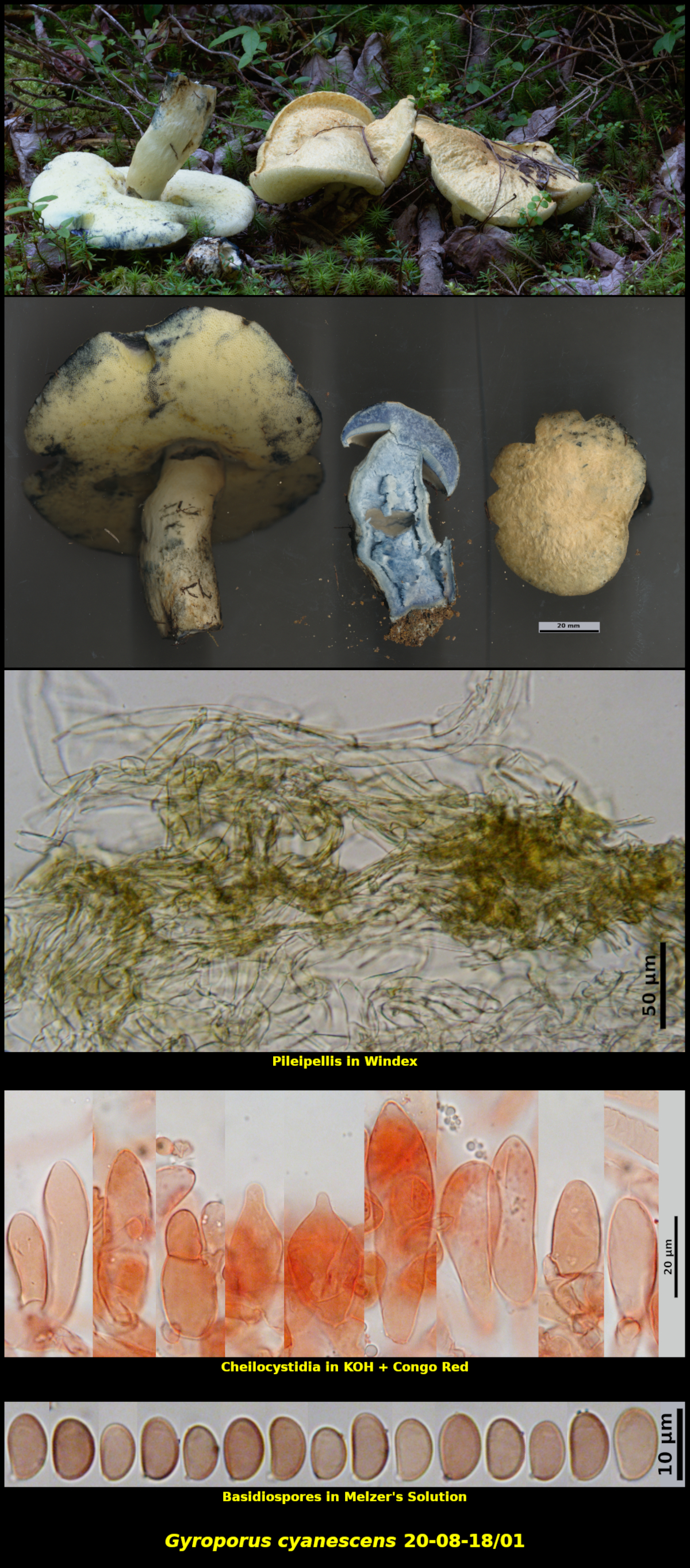Fleshy Fungi of New Brunswick >>
Gyroporus cyanescens
Gyroporus cyanescens (Bull.) Quél.

Gregarious to clustered in soil and mosses at edge of old woods road, associated with Abies balsamea, Picea rubens and Larix laricina, N. of Lepreau, New Brunswick (20-08-18/01).
Pileus convex-hemispherical at first, expanding to more broadly convex at maturity, dry, glabrous but with surface having a low but coarse texture of warts and ridges resembling scales, not at all shiny, dull orange yellow (HSV40:15:100), instantly staining blue (HSV210:90-100:50-70) where bruised, 60-126 mm in diameter. Stipe equal to slightly clavate, white to very pale yellowish white (HSV50:01-02:100), instantly staining blue (HSV210:90-100:50-70) where bruised or cut, dry, smooth, glabrous, 55-100 X 14-23 mm. Pores white to cream (HSV35:02-03:100) at first. later becoming yellow (HSV55:20-25:100), instantly staining blue (HSV210:90-100:50-70) where bruised or cut, about 1 mm in diameter, adnexed. Flesh white to slightly yellowish white in both pileus and stipe, instantly staining blue (HSV210:90-100:50-70) where bruised or cut, with a nondescript mushroom odour and taste.
Basidiospores pale yellow (HSV45:10:100) in spore print, ellipsoidal to phasaeoliform, smooth, dextrinoid, 7.2-10.3 x 4.9-6.3 µm, Q = 1.42-1.84 (average[43]: 8.8 x 5.4 µm, Q = 1.62). Pileipellis a thick tomentose layer composed of a loose dry cutis of finely encrusted yellow hyphae seated upon an ascending and loosely interwoven subpellis. Cheilocystidia abundant around the tube openings, variously cylindrical to clavate, occasionally ventricose with a broadly mucronate apex, with a basal clamp connection, 22-56 x 10-17 µm. Pleurocystidia not observed. Basidia clavate, 4-spored, with a basal clamp connection.
This mushroom is unmistakable due to its pale colours, yellow spore print and flesh that instantly turns intensely blue when cut. Microscopically it is caharacterized by its broadly rounded basidiospores, unusual in shape for a bolete.

Many authors recognize two varieties of G. cyanescens: the type variety cyanescens which changes colour when cut first to greenish yellow and then blue, and the variety violaceotinctus, with cut flesh first turning dark lilaceous and then indigo. Collection 20-08-18/01 may fit best in the latter variety, although this is difficult to declare with confidence. There appear to be several definitions of the colour indigo, with an HSV hue ranging from 203 to 275. Two two varieties have yet to be investigated using molecular methods. The image at left, an extract of Indigo plant applied to paper by Palladian, is quite close to the colour of Collection 20-08-18/01.
Photograph of basidiomata: D. Malloch (20-08-18/01).